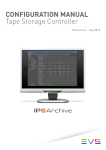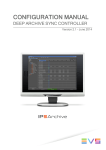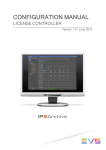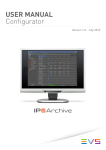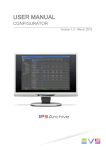Download Tape Storage Controller configuration manual 5.1
Transcript
CONFIGURATION MANUAL TAPE STORAGE CONTROLLER Version 5.1 - June 2014 CONFIGURATION MANUAL IP2Archive 1.4 Tape Storage Controller 5.1 Copyright EVS Broadcast Equipment SA– Copyright © 2003-2014. All rights reserved. Disclaimer The information in this manual is furnished for informational use only and subject to change without notice. While every effort has been made to ensure that the information contained in this user manual is accurate, up-to-date and reliable, EVS Broadcast Equipment cannot be held responsible for inaccuracies or errors that may appear in this publication. Improvement Requests Your comments will help us improve the quality of the user documentation. Do not hesitate to send improvement requests, or report any error or inaccuracy on this user manual by e-mail to doc@evs.com. Regional Contacts The address and phone number of the EVS headquarters are usually mentioned in the Help > About menu in the user interface. You will find the full list of addresses and phone numbers of local offices either at the end of this user manual (for manuals on hardware products) or at the following page on the EVS website: http://www.evs.com/contacts. User Manuals on EVS Website The latest version of the user manual, if any, and other user manuals on EVS products can be found on the EVS download center, on the following webpage: http://www.evs.com/downloadcenter. I CONFIGURATION MANUAL IP2Archive 1.4 Tape Storage Controller 5.1 Table of Contents Table of Contents TABLE OF CONTENTS III WHAT'S NEW IV 1. ABOUT THE APPLICATION 1 2. MULTIPLE TIMECODE SUPPORT 1 3. STARTING THE APPLICATION 2 3.1. After Installation 2 3.2. After Configuration 2 3.3. Version and License Check 3 3.4. Main Window Overview 5 3.5. Overview Tasks 8 4. 9 CONFIGURING THE APPLICATION 4.1. Settings Window 9 4.2. System Settings 11 4.2.1. Overview System Settings Subcategories 11 4.2.2. MAD Options Tab 12 4.2.3. Oracle Connection Tab 15 4.2.4. E-Mail Options Tab 17 4.2.5. Timers Tab 19 4.2.6. Tasks Tab 19 4.2.7. HSMs Tab 20 4.2.8. DIVA Tab 21 4.2.9. ADA Tab 25 4.2.10. FlashNet Tab 27 III EVS Broadcast Equipment SA Issue 5.1.D - June 2014 What's New In the Configuration Manual of the Tape Storage Controller the icon has been added on the left margin to highlight information on new and updated features. The changes linked to new features in version 5.1 are listed below. The version of the application and the validity of the license are checked at startup. • See section "Version and License Check" on page "3". The version of the ADAwrapper.dll and DivaApiwrapper.dll is checked. The splash screen now also displays the database name and version and the date until which the license is valid. • See section "Main Window Overview" on page "5". The Retrieve Tape ID task has been implemented for ADA and FlashNet. • See section "Overview Tasks" on page "8". Partial restore for ADA has been implemented. The settings have been rearranged. An e-mail notification is sent when no empty tapes are available in the tape library. • See section "MAD Options Tab" on page "12". An e-mail notification is sent when an empty tape is available in the tape library. The ID of the tape to be inserted is mentioned. • See section "MAD Options Tab" on page "12" An e-mail notification is sent when the LTO tape containing the file that needs to be restored is offline. This has been implemented for FlashNet and DIVA. • See section "MAD Options Tab" on page "12". Support for multiple tape groups has been implemented for ADA, FlashNet and DIVA. Support for loresless workflow has been implemented. IV What's New CONFIGURATION MANUAL IP2Archive 1.4 Tape Storage Controller 5.1 1. About the Application General Description Tape Storage Controller is an automated application or robot that interacts with the hierarchical storage management system to drive all the archive, (partial) restore and purge requests originating from the Deep Archive Controller. Tape Storage Controller interfaces with the following HSM systems: Atempo's Digital Archive, SGL's FlashNet, Front Porch Digital's DIVArchive. Workflow The diagram below shows the interactions between IPDirector and the various IP2Archive software components, and between the various IP2Archive software components and the HSM system. When IP2Archive interfaces with XenData's Digital Archive, Tape Storage Controller is replaced by File Transfer Daemon. 2. Multiple Timecode Support The application supports the following SMPTE timecodes: • PAL • NTSC non-drop frame • NTSC drop frame 1. About the Application 1 EVS Broadcast Equipment SA 3. Starting the Application 3.1. After Installation Issue 5.1.D - June 2014 Double-click the Tape Storage Controller icon to start the application. You can also start the application by double-clicking the executable file (.exe) in the installation folder. The splash screen appears. The application logs into the database. Then, the Settings window appears allowing you to configure the application. See section "Configuring the Application" on page "9". 3.2. After Configuration Double-click the Tape Storage Controller icon to start the application. You can also start the application by double-clicking the executable file (.exe) in the installation folder. The splash screen appears. The application logs into the database. Then, the main window opens. After a time interval defined in the settings, the application automatically starts performing its active tasks. 2 3. Starting the Application CONFIGURATION MANUAL IP2Archive 1.4 Tape Storage Controller 5.1 3.3. Version and License Check Introduction The version of the application and the validity of the application license will be checked when the application logs into the IP2Archive database at startup. The status of the version or the license that is returned is displayed on the application splash screen. Version and License Statuses The following version and license statuses can be returned: Status Description Color Action Required Current The actual version of the application. no color No action required. The application starts automatically. Outdated A newer version of the application exists, but this version can still be used. red By default, the application starts automatically after 10 seconds. The application version that should be installed is displayed. Obsolete A newer version of the application exists and must be used. This version may not be used anymore. Click OK to start the application at once. red Click OK to continue. The application shuts down. The application version that should be installed is displayed. Undefined The version of the application is not defined in the MAD database. black Click OK to continue. The application shuts down. 3. Starting the Application 3 EVS Broadcast Equipment SA Issue 5.1.D - June 2014 Status Description Color Action Required Beta A test version. blue Click OK to start the application. By default, the application starts automatically after 10 seconds. License About to Expire The license period is about to expire. It is shown in how many days the license will expire. orange By default, the application starts automatically after 10 seconds. Contact your system administrator or check the License Controller manual. License Expired The license period has expired. The date when the license expired is displayed. Click OK to start the application at once. red Click OK to continue. The application shuts down. Contact your system administrator or check the License Controller manual. No Valid License There was no valid license found in the database. red The application shuts down. Contact your system administrator or check the License Controller manual. Maximum Licenses Reached The maximum number of instances <NUMBER OF LICENSES> for the license has been reached. Click OK to continue. red Click OK to continue. The application shuts down. Contact your system administrator or check the License Controller manual. 4 3. Starting the Application CONFIGURATION MANUAL IP2Archive 1.4 Tape Storage Controller 5.1 3.4. Main Window Overview General Description The main window displays the active and non-active tasks of the application. It allows you to monitor the tasks that are being performed. It also allows you to manually start and stop the application or a particular task. Illustration The main window contains the areas highlighted on the screenshot below: Area Description The table below describes the various parts of the main window: Part 1. 3. Starting the Application Name Description Menu bar The menu bar contains three menus: File, Settings and Help. 5 EVS Broadcast Equipment SA Part 2. Issue 5.1.D - June 2014 Name Description Tasks pane The Tasks pane contains the name and a brief description of the tasks performed by the application. Only the tasks that were activated by you in the System settings will be performed at start-up. If you want to manually run certain tasks for test purposes, you have to stop the application, select the corresponding check box in the Active column, and then click the Start button. This button only becomes available after you have clicked the Stop button. 3. Start/Stop buttons These buttons are used to manually start and stop the application. 4. Log pane The Log pane lists application events (= logs) and can be useful. The date and time of each event is displayed. These logs are also saved in the log files. Menu Bar The menu bar contains three menus: File, Settings and Help. File Menu The File menu contains only one command: Exit. It is used to exit the application. Click the File menu or use the keyboard shortcut keys ALT + F or F10 + F to open it. Click Exit or use the keyboard shortcut key X to exit the application. Settings Menu The Settings menu does not contain any commands. It immediately gives access to the application settings. Click the Settings menu or use the keyboard shortcut keys ALT + S or F10 + S to access the settings. Help Menu With the About command the application about box can be opened. The about box displays the application software version, the date until which the application license is valid, the name and version of the database the application is logged on to and the login name used. Click About or use the keyboard shortcut key A to open the about box. Note These menus only become available after you have clicked the Stop button. 6 3. Starting the Application CONFIGURATION MANUAL IP2Archive 1.4 Tape Storage Controller 5.1 3. Starting the Application 7 EVS Broadcast Equipment SA 3.5. Issue 5.1.D - June 2014 Overview Tasks The table below gives a brief description of the tasks performed by Tape Storage Controller. Number Task Description 2 Request Backup Checks the IP2Archive database for archive requests and commands the HSM to start the archiving process. 3 Request Restore Checks the IP2Archive database for restore requests and commands the HSM to start the restore process. 4 Request Purge Checks the IP2Archive database for purge requests and commands the HSM to start the purge process. 6 Update Backup Progress Checks the status and progress of the archive jobs and synchronizes this information with the IP2Archive database. 7 Update Restore Progress Checks the status and progress of the restore jobs and synchronizes this information with the IP2Archive database. 8 Update Purge Progress Checks the status and progress of the purge jobs and synchronizes this information with the IP2Archive database. 9 Retrieve Tape IDs Retrieves the LTO tape ID from the HSM after the files have been archived to LTO. Note For performance reasons, two or more instances of the Tape Storage Controller can be installed. Each instance can be configured to perform only a specific set of the tasks mentioned above. For example, there could be an instance that only performs the archive and purge tasks, and an instance that only performs the restore tasks. 8 3. Starting the Application CONFIGURATION MANUAL IP2Archive 1.4 Tape Storage Controller 5.1 4. Configuring the Application 4.1. Settings Window Opening the Settings Window The Settings window allows you to configure your application. The first time the application is launched after it has been installed, the Settings window opens automatically. The Settings window can also be accessed through the Settings menu in the main window. To make this menu available, click the Stop button. The application will stop performing its tasks. 4. Configuring the Application 9 EVS Broadcast Equipment SA Issue 5.1.D - June 2014 Edit Mode To be able to edit the settings, you first have to enter a password. To put the Settings window into Edit Mode, proceed as follows: 1. Click the Enter Into Edit Mode button . A dialog box appears. 2. Enter the administrator password and then click OK. The Settings window enters into Edit Mode. Note Certain settings are read-only and cannot be configured. These can only be modified in the Configurator application. Other settings have to be configured locally. 10 4. Configuring the Application CONFIGURATION MANUAL IP2Archive 1.4 Tape Storage Controller 5.1 4.2. System Settings 4.2.1. Overview System Settings Subcategories The System settings are divided into the following subcategories: • MAD Options • Oracle Connection • E-Mail Options • Timers • Tasks • HSMs • DIVA • ADA • FlashNet For each subcategory a tab is provided. 4. Configuring the Application 11 EVS Broadcast Equipment SA 4.2.2. Issue 5.1.D - June 2014 MAD Options Tab The MAD Options tab contains the settings that configure the log file management and the archive and restore process. Configuring the Archive Process The settings that configure the archive process are read-only and can only be configured from within the Configurator. See the Configurator user manual for more information. Sorting Archive Requests If the setting Smart Sort Requests by Group is enabled, Tape Storage Controller will sort all archive requests by tape group and request them in order to the HSM (DIVA, ADA, XenData, FlashNet). When requests of the same tape group are processed sequentially, the tape robot will not have to change tapes that often. By default, this setting is selected. For this setting to be effective the 'max Archive' setting has to be bigger than 2, so sorting by tape group matters. Checking for Available Tapes If a user tries to archive a clip and all tapes belonging to a particular tape group are full and no empty tape is available in the LTO tape library, the clip will go into error in the Archive Queue tab of the Deep Archive Manager, and the following error message will be displayed: 12 • When interfacing with DIVA: 'No migrate archive service: No online tape fits the requirements. Please insert an empty tape and retry'. • When interfacing with ADA: 'No Media available in scratch media group. Please insert empty tapes and retry'. 4. Configuring the Application CONFIGURATION MANUAL IP2Archive 1.4 Tape Storage Controller 5.1 • When interfacing with Flashnet: 'There is no empty tape available for <VARID>. Please insert an empty tape and retry'. Tape Storage Controller will also send an e-mail message with the following error message to the recipients as configured in the External Mail tab of the E-Mail Options tab: • When interfacing with DIVA: 'There is no empty tape available for <VARID>. Please insert an empty tape and retry.' • When interfacing with ADA: 'No Media available in scratch media group. Please insert empty tapes and retry.' • When interfacing with SGL: 'There is no empty tape available for <VARID> in group <GROUP_ID>. Please insert an empty tape and retry.' Checking for Ejected Tapes with Space Left If the setting Do Not Archive to Empty Tape If There Is an Ejected Tape With Space Left is enabled, Tape Storage Controller will check the database if there is a tape available in the LTO tape library with enough space left. If this is not the case, Tape Storage Controller will then check in the database if there is an ejected tape with enough space left. If this is the case, Tape Storage Controller will send the following e-mail message to the recipients as configured in the External Mail tab of the E-Mail Options tab: Application: Tape Storage Controller There is an ejected tape with enough space left for <VARID> Please insert tape <TAPEID> and retry. This message will also appear in the Archive Queue tab of the Deep Archive Manager. The corresponding clip will go into error. The user will have to wait until the tape has been inserted in the LTO tape robot and then retry to archive the file. If there are no ejected tapes with space left, or if this setting is not selected, DIVA will send an error message. Tape Storage Controller will enter this message in the database. Tape Storage Controller will send an e-mail with an error message to the recipients as configured in the External Mail tab of the E-Mail Options tab. The clip will go into error in the Archive Queue tab of the Deep Archive Manager and an error message will be displayed. See 'Checking for Available Tapes' above. Note This setting is only selected when Tape Storage Controller is used in a MAD setup and when interfacing with DIVA. Marking Files as Archived If the setting Mark File as ‘Archived’ Only After It Has Been Written to Tape is enabled, Tape Storage Controller will wait to mark a file as being archived in the IP2Archive database until the file has been written to LTO tape. In the Deep Archive Manager GUI the file will then be moved to the Archived tab only after the file has been written to LTO tape. By default, this setting is selected. 4. Configuring the Application 13 EVS Broadcast Equipment SA Issue 5.1.D - June 2014 If the setting Check if Source File Exists is enabled, Tape Storage Controller will first check if the file to be archived really exists. If the file does not exist, it will not start the archive process. The clip will go into error in the Archive Queue tab of the Deep Archive Manager and the following error message will be displayed: 'File not found: <FILENAME>.' Clear this setting if Tape Storage Controller has no access to the storage location of the source file. By default, this setting is selected. Configuring the Restore Process The settings that configure the restore process are read-only and can only be configured from within the Configurator. See the Configurator user manual for more information. Sorting the Restore Requests If the setting Smart Sort Requests by Group is enabled, Tape Storage Controller will sort all restore requests by tape group and request them in order to the HSM (DIVA, ADA, XenData, FlashNet). When requests of the same group are processed sequentially, the tape robot will not have to change tapes that often. However, the priority level of the files won’t be considered then. By default, this setting is selected. Configuring the Log File Management To be able to configure the log file management, you have to select the Log Files check box. In the Directory field you can enter the path of the log storage directory or you can browse for it by clicking . By default, the logs will be saved in the directory: C:\EVSLogs\MAD\ [Application name]. If the A New Log Every Day check box is selected, a new log file is started every day. By default, this option is not selected. You can also specify a time interval (in days) after which the logs should be removed from the log storage directory. If you enter ‘-1’, the logs are never removed from the storage directory. By default, the logs are cleaned up after 90 days. Configuring the LogMemo Size In the LogMemo group box you can specify the maximum number of lines retained by the Log pane. By default, the Log pane displays 256 lines. 14 4. Configuring the Application CONFIGURATION MANUAL IP2Archive 1.4 Tape Storage Controller 5.1 4.2.3. Oracle Connection Tab The Oracle Connection tab allows you to configure the connection with the Oracle database. Entering the Database Name In this field you have to enter the name of the database the application has to connect to. If the Use This Database Name check box is selected, the name of the database will automatically appear in the Oracle login dialog box at start-up. Entering the Login Name In this field you have to enter a login name. If the Use This Login Name check box is selected, the login name will automatically appear in the Oracle login dialog box at startup. Entering a Password In this field you have to enter a password. If the Use Auto Login check box is selected, the application automatically logs into the selected database at start-up. The Oracle login dialog box does not appear. 4. Configuring the Application 15 EVS Broadcast Equipment SA Issue 5.1.D - June 2014 Checking Application History By clicking the Application History button, you can open a chronological list of all software versions of the application. To get more details about each version (creation date, name of programmer, status, additional remarks), you have to click + next to the version number. Activating Keep Alive If the option Keep Connection Alive is selected, a message is sent to the database at regular time intervals to avoid idle connections from being closed by the firewall. These intervals can be set by you. If the option Try to Reconnect if Keep Alive Fails is selected, the application will try a number of times to reconnect with the database. If the option Report Status in Database Everytime Keep Alive Timer Triggers is selected, the status of the connection is reported in the database each time the Keep Alive Timer sends a trigger to send a Keep Connection Alive message. If the option Report Status of Tasks is selected, the status of the tasks (ok or not ok) is reported to the database. Testing the Oracle Connection The Test Oracle button allows you to check the validity of the database name, login and username you entered. If these data are valid, then the following message appears next to the Test Oracle button: ‘OK’. If the login name or password is invalid, then a message box appears with the following message: ‘ORA-01017: invalid username/password; logon denied’. If the database name is invalid, then a message box appears with the following message: ‘ORA-12154:TNS: could not resolve the connect identifier specified’. If you omit the password, then a message box appears with the following message: ‘ORA-01005: null password given; logon denied’. If you do not enter a database name, login and username, then a message box appears with the following message: ‘ORA-12560: TNS: protocol adapter error’. You can also check the software version of the application by clicking the Test Oracle button. If the software version is up-to-date, then the following message appears: ‘Current– The Current Version’. If the software version is outdated, then the following message appears: ‘Unknown Version Application! Please contact the EDP department.’ If you close the Settings window without testing the validity of the database name, login and username you just entered, then a message box appears. 16 4. Configuring the Application CONFIGURATION MANUAL IP2Archive 1.4 Tape Storage Controller 5.1 If you click Yes, then the Settings window is closed and the original values are restored. If you click Cancel, then the Settings window does not close and you can test the values by clicking the Test Oracle button. If you change the current database settings, test the connection and then close the Settings window, a message box will appear. If you click Yes, the application is stopped and closed. A manual restart will be required. Click Cancel to continue. 4.2.4. E-Mail Options Tab In case the application is capable of sending e-mail messages, the E-Mail Options tab will allow you to configure an e-mail account, enter the e-mail address of the default sender and recipients, and enter a default e-mail subject. If the application is not capable of sending e-mail messages, the settings in this tab cannot be used. To be able to configure the e-mail account, you have to select the Send E-Mail check box. The fields in the Mail System Settings and Mail Message Settings group box become available. Configuring an E-Mail Account In the Mail System Settings group box you have to enter the IP address and port number of the SMTP server and specify a timeout. In the SMTP Login group box you can enter a user name and password. 4. Configuring the Application 17 EVS Broadcast Equipment SA Issue 5.1.D - June 2014 Configuring a Default E-Mail Message The Mail Message Settings group box contains two tabs: Internal Mail Settings and External Mail Settings. The Internal Mail Settings tab can be used to configure a default e-mail message that will be sent to the EVS developers and the customer when an error occurs. The External Mail Settings tab can be used to configure a default e-mail message that will be sent to the customer to notify him about an error. In each tab you have to enter the sender’s email address, the email address of the various recipients and a subject. It should be noted that this tab is not always used. When you insert multiple e-mail addresses in any of the header fields, make sure you separate them by a comma. To test the settings and manually send an e-mail message, click the Send Mail button. For the new settings to take effect, close and restart the application. Check the TOM.ini file in the installation folder of the application for the e-mail addresses and subject entered here. 18 4. Configuring the Application CONFIGURATION MANUAL IP2Archive 1.4 Tape Storage Controller 5.1 4.2.5. Timers Tab The Timers tab allows you to set time intervals for some automated tasks. Configuring Auto-Start In the Auto Start group box you can specify the time interval after which the application automatically starts performing its tasks. By default, this is set to 10 seconds. Setting a Time Interval Between Tasks In the Perform Tasks group box you can specify the length of the time interval (in seconds) between two subsequent tasks. By default, this is set to 30 seconds. 4.2.6. Tasks Tab The Tasks tab gives an overview of the active tasks. In the Active by Default column you can activate the tasks that must be performed by default at start-up by selecting the corresponding check box. The Active column displays the tasks that are currently selected in the main window. 4. Configuring the Application 19 EVS Broadcast Equipment SA 4.2.7. Issue 5.1.D - June 2014 HSMs Tab The HSMs tab contains the settings that configure the communication between Tape Storage Controller and the hierarchical storage management system (HSM). The data entered here will automatically appear in the tab in the System settings that corresponds to the selected hierarchical storage management system. The data is read-only and can only be modified in the Configurator application. If a particular HSM is selected, the corresponding tab with settings specific to that HSM will become available. 20 4. Configuring the Application CONFIGURATION MANUAL IP2Archive 1.4 Tape Storage Controller 5.1 4.2.8. DIVA Tab The DIVA tab contains the settings that configure the connection between Tape Storage Controller and the DIVArchive system and also those that configure the archive and restore process performed by the DIVArchive. This tab only becomes available if DIVA has been selected as HSM type in the HSMs tab. See section "HSMs Tab" on page "20". These settings are read-only and can only be configured in the Configurator application. Configuration Connection With DIVA The Connection group box contains the following connection data: • Manager: Name of the DIVArchive Manager. The DIVArchive Manager is the main component in a DIVArchive system. All archive operations are controlled and handled by the DIVArchive Manager. • Address: IP Address of the management station running the DIVArchive Manager software component. • Port: Listening port number of the DIVArchive Manager management station. • Default Set ID: The tapes in the library are initially divided into sets, and are assigned a number called a Set ID. Set ID’s allow to partition pools of tapes in a library and assign them for use with specific DIVArchive groups. A Test button allows you to test the connection with the DIVArchive. If the connection is ok, the message ‘Success’ will appear. 4. Configuring the Application 21 EVS Broadcast Equipment SA Issue 5.1.D - June 2014 Otherwise, an error message will appear. Configuring the Archive Process The Archive group box contains settings used to configure the archive process performed by the DIVArchive system. The Source field contains the name of the system that has content intended to be transferred to DIVArchive, i.e. the nearline storage. This name is pre-defined in the DIVArchive source configuration. The Quality of Service (QOS) parameter defines how a file is to be transferred to a DIVArchive tape. The options for QOS are defined as follows: • Direct Only: The material is written to tape immediately as it is being transferred from a destination. If no direct transfer service is available, the request will be aborted. • Cache Only: The material is first transferred entirely from the source to cache storage, and then written to tape. If no cache service is available, the request will be aborted. • Direct and Cache: If a direct transfer is not available (e.g. no Actor with direct transfer enabled is available), then cache transfer will be used instead. • Cache and Direct: If cache transfer is not available (e.g. no Actor with cache storage is available), a direct transfer will be performed instead. • Default: The QOS specified in the source configuration will be used. By default, the option Cache and Direct is selected. The Options field contains additional options that must be used for performing the transfer of data from the source to DIVA. These options supersede any options specified in the DIVA configuration database. Currently the possible values are: 22 • a null string to specify no options • -r: Specifies that every name in filenamesList that refers to a directory must be scanned recursively. This also applies when a file path root is specified and ‘*’ is used to designate the file(s) to be archived. This option may be used when archiving from a local source or from a standard FTP server. • -login: Login used for some sources. • -pass: Password in conjunction with the –login option for some sources. 4. Configuring the Application CONFIGURATION MANUAL IP2Archive 1.4 Tape Storage Controller 5.1 Configuring the Restore Process The Restore group box contains settings used to configure the restore process performed by the DIVArchive system. Configuring the Transfer of the Restored File The Destination field contains the name of the system that requires content to be transferred to it from DIVArchive. This name is pre-defined in the DIVArchive destination configuration. The Quality of Service (QOS) parameter defines how a file is to be transferred from a DIVArchive tape to a destination. The options for QOS are defined as follows: • Direct Only: The material is transferred immediately to the source as it is being read. If no direct transfer service is available, the request will be aborted. • Cache Only: The material is first transferred entirely to cache storage from tape, and then transferred to the destination. If no cache service is available, the request will be aborted. • Direct and Cache: If a direct transfer is not available (e.g. no Actor with direct transfer enabled is available), then cache transfer will be used instead. • Cache and Direct: If cache transfer is not available (e.g. no Actor with cache storage is available), a direct transfer will be performed instead. • Default: The QOS specified in the destinations configuration will be used. The following additional services are available: • Default: Operate as per default setting in the Manager configuration; • Do Not Overwrite: Do not overwrite existing files on the destination server. • Do Not Check Existence: Do not check the existence of the clip on the server. • Delete and Write: Force delete and rewrite if object exists on server. The Options field contains additional options that must be used for performing the transfer of data from DIVA to the destination. These options supersede any options specified in the DIVA configuration database. Currently the possible values are: • a null string to specify no options. • -login: Login used for some sources. • -pass: Password in conjunction with the –login option for some sources. Checking and Notifying When Requested Tape is Not Available If the setting Report Error If Required Tape Is Not Inserted is selected and a request is made to restore a file that is stored on a LTO tape that is not inserted in the tape library, the corresponding clip will go into error in the Restore Queue tab of the Deep Archive Manager and the following error message is displayed: 4. Configuring the Application 23 EVS Broadcast Equipment SA Issue 5.1.D - June 2014 'The tape for <FILENAME> is not inserted in the tape robot. Please insert tape <TAPE_ID> and retry'. The user can retry restoring the file after the required tape has been inserted. If the setting is not selected, no error will be reported if an LTO tape is not inserted. By default, this setting is not selected. Tape Storage Controller will send an e-mail message with the same error message to the recipients as defined in the External Mail tab of the E-Mail Options tab. This error message will also be displayed in the Archive Progress Message field in IPDirector. 24 4. Configuring the Application CONFIGURATION MANUAL IP2Archive 1.4 Tape Storage Controller 5.1 4.2.9. ADA Tab The ADA tab contains the settings that configure the communication with the Atempo Digital Archive (ADA) system. This tab only becomes available if ADA is selected as HSM type in the HSMs tab. See section "HSMs Tab" on page "20". These settings are read-only. They can only be modified in the Configurator application. Configuration Connection With ADA In the Connection group box the following data is automatically entered: • User: Name of the user as defined in Atempo Digital Archive. • Domain: Windows domain name. • Password: Password necessary to log into Atempo Digital Archive. • Server Name: Name of the Atempo Digital Archive Server to which Tape Storage Controller will connect. You have to use the machine name. • Port: Number of the port the Atempo Digital Archive Server will listen for requests. It is port number 80 by default. • Database: Database instance used for Atempo Digital Archive. It is called ADA by default. Specification of the ADA Archive In the ADA Archive group box the following data is automatically entered: • Archive: Name of the project archive created in Atempo Digital Archive. A project archive is shared and can be accessed by several users defined by the Administrator. • Path: Folder of the project archive which mirrors the location of the data on the source platform. This folder has a path of the structure: <source_machine>\<source_ machine_OS>\root_path_on_source>. 4. Configuring the Application 25 EVS Broadcast Equipment SA Issue 5.1.D - June 2014 Specification of the Host Platform A host platform is an archiving platform where the source data to be archived is located. Depending on the setup, the settings in the Host Platform group box will be enabled or not. The host platform name, i.e. the network name of the machine hosting the data, can either be derived from the UNC path of the storage or this can be a fixed name. The first option is used when there are multiple storages, the second option is used when there is only one storage. Enable Logging If the option Enable Loggingis selected, an extensive log will be kept of the communication between Tape Storage Controller and the Atempo Digital Archive Server. Click the Test button to test this option. By default, this option is selected. Enable Retrieval of LTO Tape ID If the option Retrieve Tape ID After Archiving Has Finished, Tape Storage Controller will retrieve from the ADA database the ID of the LTO tape which contain the archived files. By default, this option is selected. 26 4. Configuring the Application CONFIGURATION MANUAL IP2Archive 1.4 Tape Storage Controller 5.1 4.2.10. FlashNet Tab The FlashNet tab contains the settings that configure the communication with the FlashNet system. This tab only becomes available if FlashNet is selected as HSM type in the HSMs tab. See section "HSMs Tab" on page "20". Most of the settings in this tab are read-only. They can only be configured in the Configurator application. The following connection data is entered: • Host : The IP address or machine name of the FlashNet server. • Port: The listening port number of the FlashNet server. The default port number is 8199. • Local Host: The IP address or machine name of the server that hosts Tape Storage Controller. This field can still be configured locally. The Reply Timeout field displays how long (expressed in seconds) Tape Storage Controller will wait for the FlashNet server to respond after making connection before giving an error . By default, this is set to 60 seconds. If the Logging Enabled check box is selected, extra logs related to FlashNet will be added to the application log files. By default, this option is selected. If the Trace Enabled check box is selected, the XML communication between Tape Storage Controller and FlashNet is added to the log files. By default, this option is not selected. The Test button can be used to test the connection with the FlashNet server. 4. Configuring the Application 27 Corporate +32 4 361 7000 North & Latin America +1 973 575 7811 EVS Headquarters Liège Science Park 16, rue Bois St Jean B-4102 Seraing Belgium To learn more about EVS go to www.evs.com Asia & Pacific +852 2914 2501 Other regional offices www.evs.com/contact EVS Broadcast Equipment is continuously adapting and improving its products in accordance with the ever changing requirements of the Broadcast Industry. The data contained herein is therefore subject to change without prior notice. Companies and product names are trademarks or registered trademarks of their respective companies.




































